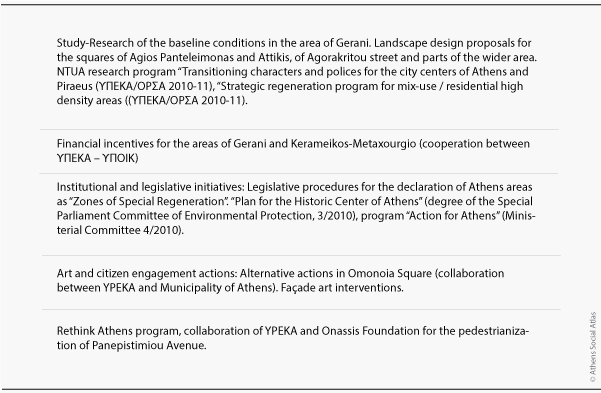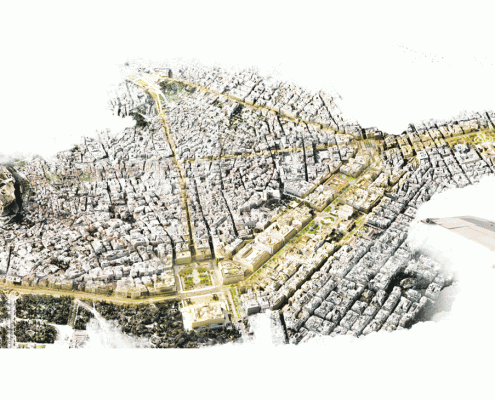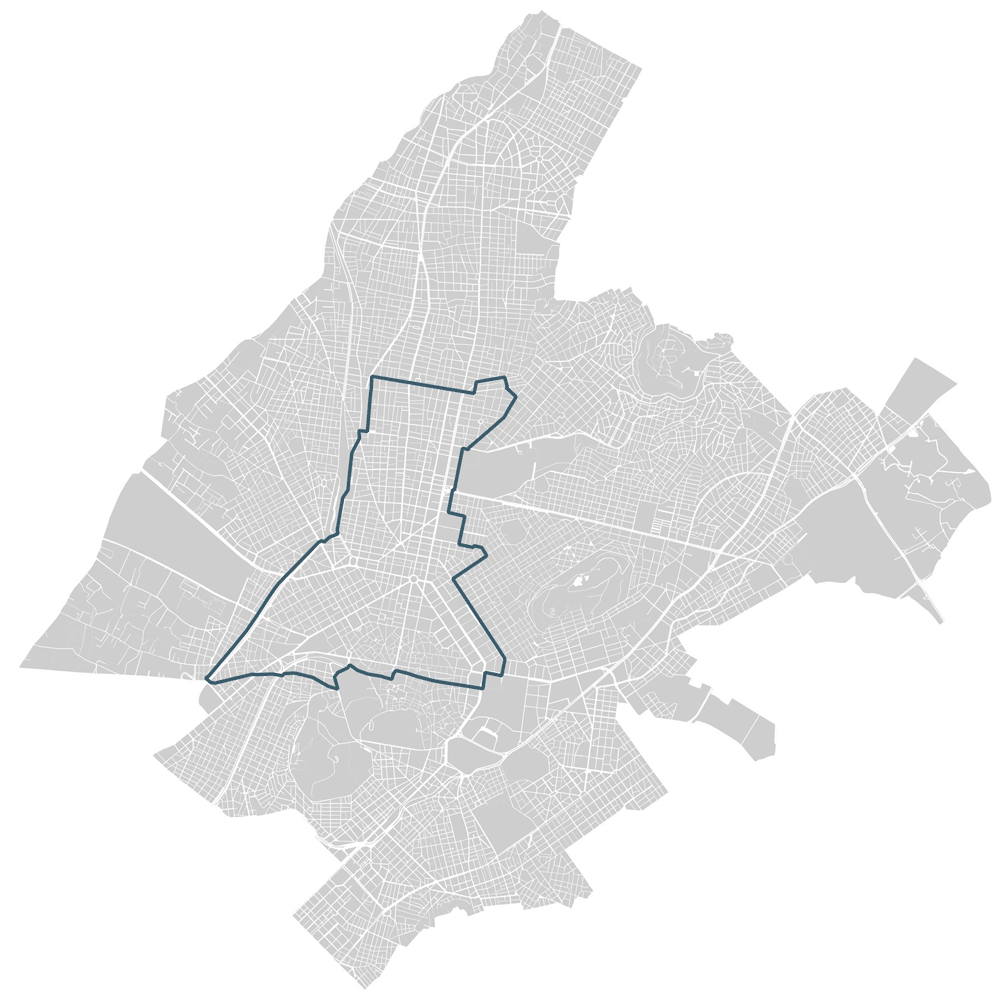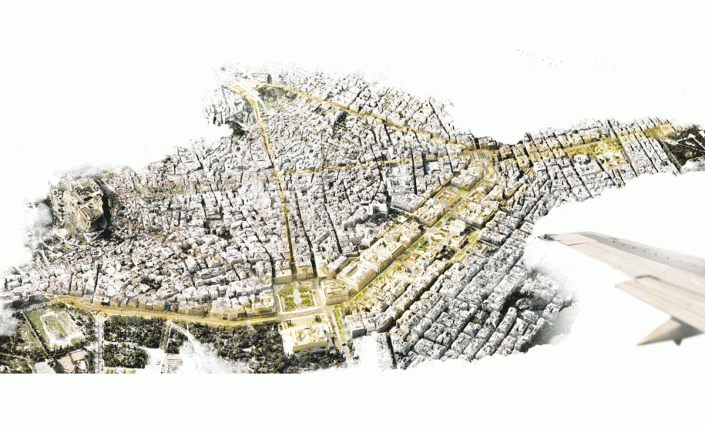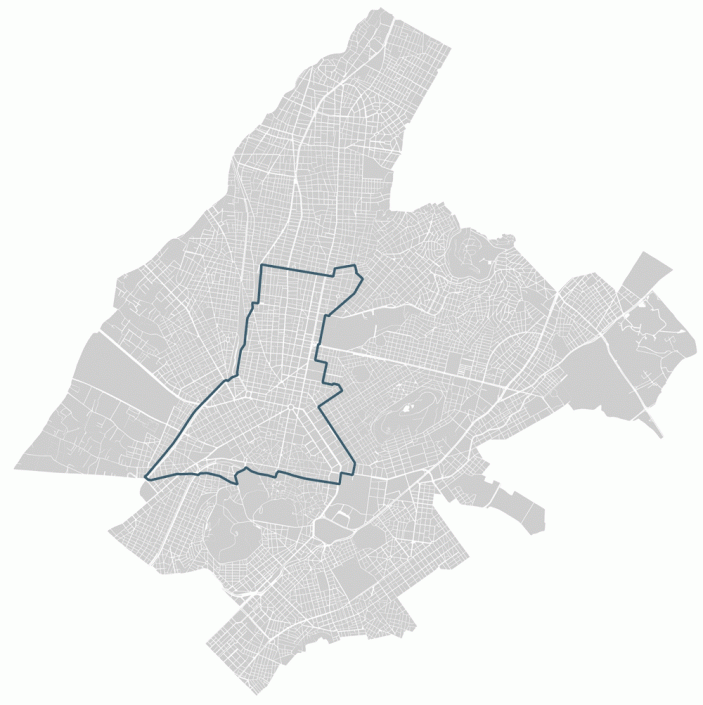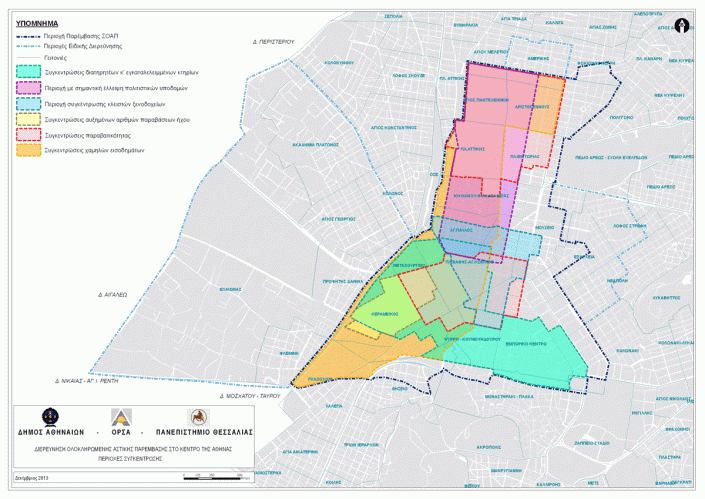Urban governance and spatial policies in Athens during a period of crisis (2009–2015): Attempts to reconstruct the city, institutional turning points and the role of Local Governments
Poulios Dimitris
Built Environment, Planning
2023 | Feb
This article explores issues of spatial policy and local governance in Athens in the period between 2009–2015, focusing on the new relationships that derive from the transition from the post-Olympics city to a period of austerity and depression. During this extremely significant and pivotal period, spatial policies evolve through the actions taken by multiple actors and institutions. This text shows these transformations through the lens of researching the institutional turning points, the views and positions of experts as well as reviewing the relevant literature. The article focuses on the Municipality of Athens, which we consider an exemplary case both for the presentation of the above transformations having taken place in a local level, and for the enhanced role ascribed to Municipalities in a context of crisis.
Introduction: From the Post-Olympics City to Recession
The period after 2004 begins with the formation of a new government by New Democracy in March 2004 (2004–2009), which assumed the post after a decade of PASOK governments (1993–2004). At the time, the dialogue regarding the city focused mostly on the issue of managing and utilizing the Olympic legacy. However, the circumstances had changed. The end of the Olympic Games in 2004 brought also an end to the system of “emergency” that had emerged during the preparation and execution of the event, while the governmental change weighed heavily on the composition of the new public administration (Beriatos and Gospodini 2004; Serraos et.al 2009; Παγώνης 2005; Pagonis 2013). This element was important, as the new cabinet seemed to be unprepared (Ζέικου 2015.12.29) and “wouldn’t even listen of the Olympic Games” (Πυργιώτης 2019.7.24), which had serious repercussions for the utilization of the infrastructure and the general urban strategy. As a result, the outcomes of this process were quite poor.
As late as 2010, from the 19 facilities, five were under the management of the Olympic Properties company, three were granted for use to bodies of the public sector, five to sports federations, and only six to private actors. Their exploitation pertained mostly to recreational, cultural or commercial use (ΙΟΒΕ 2015; Souliotis, Sayas, and Maloutas 2014; Παγώνης 2005). At the same time, the lack of strategic utilization and the management of the estates as “prestigious property” from which the state would acquire assets, while maximizing the conditions for the profitability of private investors, notably reinforced private construction firms (Souliotis, Sayas, and Maloutas 2014), establishing a context of speculation and special conditions regarding the utilization of the estates (Ευαγγελίδου 2006; Πορτάλιου 2006).
In that respect, the initial enthusiasm surrounding the Games and their potential to reshape the city began to dwindle very soon, while a few years later, the fact that Athens had missed the opportunity provided by the Olympics was a widespread view, seeing that their infrastructure was suffering the cost of abandonment (Λιάλιος 2008). For many, the management of the post-Olympics city revealed the pathologies of the planning system, and the political system in general: lack of preparation, discontinuity, lack of institutional presence and absence of strategy (Pagonis 2013; Ζέικου 2015; Κλαμπατσέα 2011; Κλουτσινιώτη 2016; Μαρμαράς 2003; Μπελαβίλας 2005; Παγώνης 2005; Πούλιος 2021) [1]. All of the above, combined with the rise of socio-spatial inequality of the same period (Arapoglou 2012; Arapoglou and Sayas 2009) created a climate of political and social polarization, which would manifest in the dialogue about the city centre (Μαλούτας 2013; Samarinis et.al 2011; Καλαντζοπούλου et.al 2011). For that matter, the city centre was the space where the broader demographic transformations and the effects of the economic crisis would be reflected more strongly. Besides, the Greek economy had already entered a period of recession in 2008.
Policies in the period between 2009–2011: Attempts to restart the city in a period of recession
The election of PASOK for government in 2009 inaugurated a period of intense debate and important initiatives within the scope of urban policy, focusing also on Athens. The transformations on a policy level pertained to issues of local governance, strategies for Athens and its public space. A large part of the policies had to do with Metropolitan Athens, but also with policies to upgrade and improve the image of the city centre.
The period started with a major institutional turning point: the rearrangement of responsibilities for the Ministry for the Environment, Physical Planning and Public Works, which would be rebranded as Ministry of Environment, Energy and Climate Change (YPEKA), in the autumn of 2009. The establishment of a new entity with duties that would concern spatial planning and energy issues, which assumed a commitment to the environmental aspect of planning –detached from the field of infrastructure–, produced a wave of optimism among the scientific community regarding the prospects of planning both for the country and for Athens itself (Pagonis 2013; Πολύζος 2019.11.22).
The most important initiatives were undertaken on a level of Metropolitan Planning by launching procedures to review the Regulatory Plan of Athens – Athens-Attica 2014 (RSA). The RSA’s strategy would be shaped by the “10+1” priority axes that YPEKA introduced in July 2011 [2]. The environmental aspect of planning, issues of environmental protection, of containment of the urban sprawl, of sustainable protection and mobility were at the heart of the proposals’ logic [3]. However, the new situation as it was shaped by crisis changed the priorities, which became obvious after 2011, and ultimately affected RSA itself.
Actions to tackle the problems in the centre of Athens were one of the main axes for project “Athens-Attica 2014”, but also for the public policies devised for Athens in the period of 2010–2011 in general (Καλτσά 2015; 2019.7.11; Πολύζος 2019.11.22).
Figure 1: The architectural ideas competition “Athens X4” was one of the first efforts to focus on solutions for the regeneration of public space in the centre of Athens (Source: EAHA AE)
We also ought to consider the policies concerning the city centre in the context of the RSA, that had far-reaching goals as well as a concrete set of goals for the central areas of the city (Πολύζος 2019.11.22). In reality, they constituted a set of actions: surveys, legislative initiatives, project proposals etc. aiming for a more comprehensive upgrade of the city centre (Table 1).
Table 1: Policies and Projects for Athens city centre 2009-2011 (Source: processed by the author).
The success of the aforementioned policies was rather limited. The deepening of crisis and recession, the lack of funding and resources as well as the change of direction in an urban policy level due to the austerity policies and the economic adjustment program completely changed its course and priorities [4].
Figure 2–4: The first prize of the architectural competition “Rethink Athens” by the OKRA office (Source: EAHA AE)
Policies in the period between 2010–2015: Economic adjustment, coping with the social effects of the crisis and new roles for Local Governments
The following period was marked by an intensification of the crisis and its social effects. On a central politics level, it was a time of instability, constant change of governments and prime ministers. Spatial policies started to adjust to the reality of the crisis and the economic adjustment program. During this period, the initiatives and actions of Greek governments for Athens largely depended on the commitments that derived from the economic adjustment program, whose main axis was the reinforcement – attraction of investments, privatizations and expenditure cuts in the public sector. Multiple changes occurred on an institutional level, which we analyze in Table 2.
Table 2: Legislative initiative in the period 2010-2014 with direct or indirect effect in urban planning and governance (Πηγή: Source: processed by the author)
Significantly, we would like to mention: the dissolvement of the public organization responsible for the strategical planning of Athens (ORSA) and the city centre regenerations (EAHA.AE) [5]. the enactment of a series of bills to accommodate and attract investments; [6] the establishment of the Hellenic Republic Asset Development Fund (TAIPED) according to Law No. 3986/2011. In particular, TAIPED, a special purpose acquisition company, was the main institution under which the entire denationalization framework and the advancement of major private investments were organized in Greece. The above processes were also reinforced by a special spatial planning system, encapsulated in the voting of Law 4269/2014 “Spatial and Urban Planning Reform-Sustainable Development”. The main turning point of this reform lies in the institutionalization of the urban planning instrument of Special Spatial Plans (SSPs) (Γιαννακούρου 2019.6.25; Κλαμπατσέα 2019.10.18; Οικονόμου 2017.9.14; Ζήφου 2018.3.28), described in Article 8 of Law 4447/2016. SSPs constitute a new planning methodology, suitable for attracting investments and parallel to conventional urban planning.
The criticism regarding these initiatives was quite strong. New institutions like TAIPED, and the special powers that they obtained, brought severe reactions and were considered by many experts as a privatization mechanism for public property with doubtful benefits. The new spatial planning system with its numerous special tools, did not bring with it a cohesive strategy for interventions, and at the same time it encouraged inconsistencies in planning. The result was the reinforcement of fragmentation, the creation of “parallel” systems, tensions between the different levels [of administration] and finally a lack of unified strategy for the city.
Another aspect of the policies focused on issues of criminality and security, particularly at the expense of migrants, whose presence had already begun to be felt in the city centre since the post-Olympics period. Even though the demands for “security” originally came from underground far-right groups, they were soon –as the crisis started to unfold– adopted by the central political agenda (Souliotis and Kandylis 2013). This shift became visible with operations of the Ministry of Public Order and Citizen Protection, such as “Xenios Zeus” in August of 2012, an operation to combat illegal migration that led to a massive mobilization of the police in the city centre, and 7,000 arrests of migrants.
At the same time, the recession period confronted Municipalities and Local Governments with a series of new challenges. The crisis and its effects, the modifications in European funding issues, as well as the international trends in the tourism industry, were some of the factors that led to the transformation of the role of Municipalities and upgraded their scope of action. The case of the City of Athens is indicative of the new situation that was beginning to take shape. In 2011, after nearly 25 years of governance by the New Democracy party, the election was won by an alliance of progressive political forces, [7] led by the former Greek Ombudsman Giorgos Kaminis, who was elected again for a second time in 2015.
In 2011, the crisis had already left its marks, and the Municipality was forced to face a situation where “social needs were turning from urgent to imperative and long-lasting” (Δήμος Αθηναίων 2015: 9). So, the fight against extreme poverty, coping with the housing shortage, labour market integration policies, issues of health and care were at the core of its policies [8]. This was pursued through a series of actions and initiatives such as the distribution of meals in primary schools and nurseries, the development of institutions such as social clinics, the enhancement of social structures such as the Citizens’ Mutual Aid Hub in the Larissa Station area, etc. (Ευμολπίδης 2018.01.18; Καμίνης 2019.11.11). These initiatives and actions were developed in a suffocating context of new restrictions in resources and manpower, inherited by the austerity policies. The intensity of the problems, the lack of financial resources and the institutional limitations, forced the Municipality to turn to European funding programs and to develop collaborations with various bodies, including solidarity movements, NGOs, or even corporations [9]. The Municipality went forward with the synergy “Athens – Capital of Solidarity” [10] to participate in actions of the Fund for European Aid to the Most Deprived (FEAD), while the activity of NGOs was also consequential in almost every field of the Municipality’s social policy.
At the same time, the tackling of its financial problems was a constant requirement, as the budget deficit reached 46 million euros in 2010. The need to further eliminate the costs and the economic adjustment policies had already resulted in severe cuts among the Municipality’s staff [11]. This gap in the field of own resources was covered by European funds that gave a serious boost. From early on, the Municipality developed initiatives to take advantage of the new conditions set by the EU regarding funding through the Integrated Spatial Investment (OXE), by also establishing new institutions for the management of these resources. In this context, ΕΑΤΑ (Athens Development and Destination Management Agency) was designated by Law 4071/2012 as an Intermediate Management Authority (IMA), responsible for the actions of Attica’s Regional Operational Program (PEP) being carried out within the City of Athens administrative boundaries. After 2012, the Municipality, with its own IMA, moved forward with “Project Athens” within the 2007–2013 NSRF framework, while also taking initiatives pertaining to the following programming period.
In a level of spatial policies and actions, the results were limited. The most noteworthy initiative was the elaboration of the Integrated Urban Intervention Plan (SOAP) in 2015, but also the maturation of a series of works in the framework of “Project Athens”.
The elaboration of SOAP, concerning the commercial and historical centre of Athens, is part of a broader attempt to shape the strategy and scheduling of projects. SOAP was a tool – action plan aiming to tackle critical problems in central areas of the City of Athens, which had been particularly accentuated since the 2008 crisis. These problems were of social, urban planning, growth and environmental character [12]. The SOAP for Athens was the first to be approved and concerned actions and objectives for the 2014–2020 period. Based on the analysis conducted, the identification of problems and potential recorded by SOAP, a broad zone was defined in the Municipality’s centre and a series of steps, actions and projects were envisioned [13]. The importance of SOAP lies in the fact that the entire strategy to attract European resources for the coming years was based on it.
Figure 5: The area of intervention of SOAP in downtown Athens. (Source: processed by the author)
Figure 6: Areas of activity concentration in SOAP’s area of intervention (Source: City of Athens)
The attempts to reconstruct and redefine the guidelines in a local level did not occur in a field that lacked criticism or without conflict. In reality, the opposite happened. For example, the City of Athens’s “openness” to citizen movements, in the framework of a new strategy to cope with the crisis and its effects, was limited only to the part of a huge solidarity network that lacked in radical characteristics (Triantafyllopoulou and Sayas 2012; Poulios, Triantafyllopoulou, and Sayas 2013). The policy of Municipalities in general toward such radical social movements was for the most part hostile and occasionally reached the point of confrontation, as in the case of self-managed and occupied spaces within the Municipality
Criticisms focused on issues of strategy and development choices. The policies to enhance the City of Athens’s appeal and competitiveness as a travel destination were questioned strongly, especially after 2017 when the spread of Airbnb and a considerable rise in the price of rents in the city centre raised important issues concerning the access to housing (Balampanidis et al. 2019). The management of the migration issue and the alignment with security reinforcement policies pursued by Greek government was another point that raised criticism. At the same time, the enhanced role of private initiatives on issues of urban intervention, and the intertwining of Municipalities and local business interests became a field of intense criticism in many cases (Μαλούτας κet al. 2013; Καλαντζοπούλου et al. 2011; Samarinis et al. 2011).
The legacy of the period between 2009–2011
The pivotal changes of the 2009–2011 period determined the following years to a large degree. Despite the government change of 2015–2019, the spatial planning reforms didn’t change at their core, while the action for Athens were quite limited at central level [14]. On the part of the Municipality, there was increased mobility and the implementation of a series of projects and initiatives [15]. There was also intense activity by the private sector (investors, foundations) that relied on the current favorable climate, but also in the policies of privatizations and of utilization of the property of public institutions.
The neoliberal shift in policy was the main legacy of this period, which was reflected on a level of policy, law-making, but also in the characteristics of urban interventions (Hadjimichalis 2017; Poulios and Andritsos 2016; Velegrakis, Andritsos, and Poulios 2015; Μαλούτας 2011). The special tools to attract investments were solidified by reinfrorcing the logic of ad hoc interventions in the urban tissue of the city. All of these were combined with the retreat of the state in a level of strategy-making around the city of Athens.
At the same time, the recession period led to significant turning points on issues of city governance, with the adoption of top-down models and the reorganization of relationships between the various levels of governance (supranational – national – regional – local). Finally, it mobilized political actors in a different way, with private initiative occupying an upgraded role.
[1] Significantly, we could mention the practical cancellation of the study – result of an international competition for the development of the former airport of Hellinikon, and the decision to relocate the Greek National Opera to Faliro (outside the city centre) as part of the Stavros Niarchos Foundation investment, showing according to Rania Kloutsinioti that “decisions are made by no matter whom” (Κλουτσινιώτη 2016).
- Promotion of cultural identity: “Athens, Mediterranean Capital”
- Emphasis on social cohesion policies
- Reconstruction of the production sector
- Reinforcement and Redistribution of Urban Development Resources
- Restriction of Off-Plan Building
- Completion of “Green Belts” and “Ecological routes”
- Urban regeneration, with land and construction recycling
- Boosting of centrality
- Strengthening of Sustainable Mobility
- Shift to the sea front
- Improvement of the spatial planning and governance system
[3] According to those involved, the Minister for the Environment, Tina Birbili, also played a key role, since as an environmentalist she had a clear focus on the protection and quality of the urban environment and supported politically a broader group working on the Regulatory Plan
[4] For example, the project Rethink Athens, despite its heavy promotion, froze due to the inability to include the work in any European funding program. Public space regeneration and upgrade policies were discontinued in general due to a lack of resources. It was only security policies that maintained momentum in the following years, combined with policies to tackle the migration issue that were quite popular in the period of 2012–2014 (Douzinas 2013; Κανδύλης 2013; Souliotis and Kandylis 2013)
[5] The existing Metropolitan governance system, with its limited capacity, was modified within a framework of reform that aimed for a broader overhaul of public institutions. Under Law 4250/2014, the Organisation of Planning and Environmental Protection of Athens and EAHA.AE were dissolved, and their jurisdiction passed over to YPEN bodies, creating a serious gap on issues of strategic planning for Athens
[6] The first step was taken under Law 3894/2010 for the “Acceleration and Transparency of Implementation of Strategic Investments”. With this particular Law, a series of rules, special measures and derogations were established for the accommodation of large investments in Greece. Further institutional initiatives followed: Law 4072/2012 “Improvement of the business environment – New corporate form – Trademarks – Realtors – Regulating maritime, port and fishing matters and other provisions”, Law 4146/2013 “Creation of a Development Friendly Environment for Strategic and Private Investments”, Law 4242/2014 “Single Carrier for Extroversion and other provisions”, Law 4262/2014 “Simplification of licensing requirements for business activities and other provisions”
[7] The electoral list of “Right to the City” was an alliance between PASOK, DIMAR and Ecologoi-Prasinoi (Ecologist Greens)
[8] Here, we should mention that, since the Kallikratis reform in 2010, a significant part of the duties pertaining to social policy were transferred to Municipalities
[9] In a context of donations and social responsibility programs
[10] The Synergy consisted of the organizations: City of Athens Reception and Solidarity Centre (KYADA), Municipal Nursery of Athens, Holy Archdiocese, and the non-governmental organizations “Nostos”, “ARSIS”, Greek Forum of Refugees, Civil Non-Profit Organization Equal Society, “Diotima”, PRAKSIS, Thryallida, KETHEA MOSAIC, “To Mirmigi”, Food Bank, SOS Children’s Villages, Caritas, Prolepsis, ELIX, Network for Children’s Rights, EADAP, Médecins du Monde (Δήμος Αθηναίων 2015).
[11] The budget of the 2010–2017 period was cut by 20% and the permanent staff by over 30%. Under these circumstances, comes the decision for the rationalization of finances, the payment of debts and the restriction of expenditure. This fact would have severe consequences on the technical program, which was limited to 10 million euros (from the initial 60 million euros) (Ευμολπίδης 2018)
[12] SOAPs were provided and defined by YPEKA decision 18150/2012 as well as by Law 2742/1999, but the tool cannot be applied until its use in the case of City of Athens
[13] The objectives regarding the area of intervention are:
- Support of the economic base.
- Restitution of the social and cultural cohesion – Rehabitation.
- Restoration of conditions of security and lawfulness.
- Recovery and upgrade of public space.
- Improvement of environmental conditions and urban planning operation.
- Reinforcement of the city’s identity and image.
- Improvement of the governance, planning and participation mechanisms.
The implementation of the above set of goals was pursued through the formation of 64 actions, grouped into 18 axes.
[14] At central level, there was a series of initiatives, but with limited application. In March 2017, the government announced the plan “New Athens”, a project of five major interventions in the city that included: The regeneration of the area of Prosfygika and Kountouriotika, the upgrade of Votanikos area, Goudi, the construction of a new Stadium for PAO, the regeneration of Athens’s historical/commercial triangle, as well as the provision of incentives for growth of professional use. From the aforementioned actions, the only one that could be partially applied concerned the centre of Athens and particularly the project to utilize the properties of public institutions.
A major initiative appeared a year later, with the founding of the company “Athens Anaplasis SA”. The new special purpose entity came to fill the gap that the dissolvement of organization like ORSA and EAHA AE had left behind, and aims to move forward with major interventions in the City of Athens (Μπελαβίλας 2019). From the very beginning, the reactions on the part of the City of Athens were violent, while the administrative classification of the company under the supervision of the Ministry of State and the Ministry of Infrastructure, along with the limited role of YPEN (Κλαμπατσέα 2018; Καμίνης 2019) created ambiguities regarding the role and purpose of the new organization, who indeed confined its actions within the limits of the City of Athens. The new organization’s efficiency was also limited as the announced work remained for the most part on a level of intentions and proposals, by conducting an architectural competition for the centre of Athens.
[15] At regional level, the City of Athens proceeded with a series of projects and initiatives such as the realization of a series of regeneration projects that had been programmed in previous years through “Project Athens” and the financial support of European funds. At the same time, through private funding and donations, we saw the realization of a series of project, such as the project to upgrade the commercial triangle of Athens (Athens Trigono), the regeneration program for Lycabettus Hill, as well as the development of Municipality’s Resilience Strategy.
Entry citation
Poulios, D. (2023) Urban governance and spatial policies in Athens during a period of crisis (2009–2015): Attempts to reconstruct the city, institutional turning points and the role of Local Governments, in Maloutas T., Spyrellis S. (eds) Athens Social Atlas. Digital compendium of texts and visual material. URL: https://www.athenssocialatlas.gr/en/article/urban-governance-and-spatial-policies-in-athens-during-a-period-of-crisis/ , DOI: 10.17902/20971.111
Atlas citation
Maloutas T., Spyrellis S. (eds) (2015) Athens Social Atlas. Digital compendium of texts and visual material. URL: https://www.athenssocialatlas.gr/en/ , DOI: 10.17902/20971.9
References
- Arapoglou V P (2012) “Diversity, Inequality and Urban Change.” European Urban and Regional Studies 19 (3): 223–37.
- Arapoglou V P and Sayas J (2009) “New Facets of Urban Segregation in Southern Europe: Gender, Migration and Social Class Change in Athens.” Εuropean Urban and Regional Studies 16 (4): 345–62.
- Balampanidis D, Maloutas T, Papatzani E, and Pettas D (2019) “Informal Urban Regeneration as a Way out of the Crisis? Airbnb in Athens and Its Effects on Space and Society.” Urban Research & Practice 0 (0): 1–20.
- Beriatos E and Gospodini A (2004) “Glocalising Urban Landscapes: Athens and the 2004 Olympics.” Cities 21 (3): 187–202.
- Douzinas C (2013) “Athens Rising.” European Urban and Regional Studies 20 (1): 134–38.
- Hadjimichalis C (2017) Crisis Spaces: Structures, Struggles and Solidarity in Southern Europe. 1 edition. Abingdon, Oxon ; New York, NY: Routledge.
- Pagonis A (2013) “The Evolution of Metropolitan Planning Policy in Athens over the Last Three Decades: Linking Shifts in the Planning Discourse with Institutional Changes and Spatial Transformation.” In: Changing Cities Conference. Skiathos: University of Thessaly.
- Poulios D and Andritsos T (2016) “Urban Politics towards a New Paradigm? Reflections on the Crisis-Driven Regulatory Reforms in Greece.” In Schönig B and Schipper S (eds) Urban Austerity: Impacts of the Global Financial Crisis on Cities in Europe. Berlin: Theater Der Zeit, pp 70-87
- Poulios D, Triantafyllopoulou E and Sayas J (2013) “Crisis and the Collapse of the Welfare State: The Different Facets of Solidarity.” In RC21 Conference 2013: Resourceful Cities. Berlin: Humbolt University.
- Samarinis P, Chatzikonstantinou E, and Spanou D (2011) “The Centre of Athens ‘in Crisis’: In Search of Critical Approaches and Alternative Practices.” In 6th International Conference of Critical Geography – ICCG . Frankfurt, Germany
- Serraos K, Asprogerakas E, and Ioannou B (2009) “Planning Culture and the Interference of Major Events: The Recent Experience of Athens.” In Othengrafen F (eds) Planning Cultures in Europe, 1 edition. London: Routledge, pp 205-221
- Souliotis N, Sayas J and Maloutas T (2014) “Megaprojects, Neoliberalization, and State Capacities: Assessing the Medium-Term Impact of the 2004 Olympic Games on Athenian Urban Policies.” Environment and Planning C: Government and Policy 32.
- Triantafyllopoulou E and Sayas J (2012) “Neighbourhoods Fighting Crisis”.” In IIPPE Conference. Paris.
- Velegrakis G, Andritsos T, and Poulios D (2015) “Uneven Development: Lessons from the Ongoing Greek Tragedy.” Human Geography 8 (3): 79–82.
- Δήμος Αθηναίων (2015) Πρόγραμμα Κοινωνικής Πολιτικής 2015-2019. Αθήνα: Δημος Αθηναίων.
- Ευαγγελίδου M (2006) “Πως Αντιμετωπίζεται η Κτηματομεσιτική Κερδοσκοπία Σε Μια Χώρα Όπου ο Νεοφιλελευθερισμός Συμπλέει Με Τον Παραδοσιακό Πολιτικό Λαϊκισμό.” Στο: 4ο Ευρωπαϊκό Κοινωνικό Φόρουμ, Αθήνα, Μάϊος 4.
- ΙΟΒΕ (2015) “The Impact of the 2004 Olympic Games on the Greek Economy.” Αθήνα: ΙΟΒΕ.
- Καλαντζοπούλου M, Κουτρολίκου Π, και Πολυχρονιάδη Κ (2011) “O Κυρίαρχος Λόγος Για Το Κέντρο Της Αθήνας….” Encounter Athens (blog). May 15, 2011. https://encounterathens.wordpress.com
- Καλτσά Μ (2015) “Το Πρόγραμμα ‘Αθήνα-Αττική 2014.’” Στο: Κοινωνικός Άτλαντας Της Αθήνας. Ηλεκτρονική Συλλογή Κειμένων Και Εποπτικού Υλικού, Στο: Μαλούτας Θ και Σπυρέλλης Σ.Ν (επ.) https://www.athenssocialatlas.gr/
- Κανδύλης Γ (2013) “Ο Χώρος Και ο Χρόνος Της Απόρριψης Των Μεταναστών Στο Κέντρο Της Αθήνας.” Στο Μαλούτας Θ et al. (επ) Το Κέντρο Της Αθήνας Ως Πολιτικό Διακύβευμα. Αθήνα: ΕΚΚΕ, σελ 257-79
- Κλαμπατσέα (2011) “Χωρικά Αποτυπώματα Και Προκλήσεις Σχεδιασμού Σε Συνθήκες Κρίσης: η Ελληνική Περίπτωση.” Στο: Μεταβολές κι ανασημασιοδοτήσεις του χώρου στην Ελλάδα της κρίσης. Βόλος: Πανεπιστήμιο Θεσσαλίας
- Λιάλιος Γ (2008) “Χάσαμε Την Ευκαιρία Των Ολυμπιακών.” Καθημερινή, Μάρτιος 23, 2008.
- Μαλούτας Θ (2011) “Χωρικές Και Κοινωνικές Επιπτώσεις Της Κρίσης Στην Αθήνα: Από Τις Ρυθμίσεις Του Πελατειακού Κράτους Στην Κρίση Των Ελλειμμάτων.” Επιθεώρηση Κοινωνικών Ερευνών 134 (134–135): 51–70.
- Μαλούτας Θ (2013) “Η Υποβάθμιση Του Κέντρου Της Αθήνας Και Οι Επιλογές Περιοχής Κατοικίας Από Τα Υψηλά Και Μεσαία Στρώματσ.” In Το Κέντρο Της Αθήνας Ως Πολιτικό Διακύβευμα, Στο Μαλούτας Θ et al. (επ) Το Κέντρο Της Αθήνας Ως Πολιτικό Διακύβευμα. Αθήνα: ΕΚΚΕ, σελ 29-51
- Μαλούτας Θ, Κανδύλης Γ, Πέτρου Μ, Σουλιώτης Ν (2013) “Εισαγωγή: Η Επαναφορά Του Ζητή Ατος Του Κέντρου Της Αθήνας Στην η Ερήσια Διάταξη.” In Το Κέντρο Της Αθήνας Ως Πολιτικό Διακύβευμα, Στο Μαλούτας Θ et al. (επ) Το Κέντρο Της Αθήνας Ως Πολιτικό Διακύβευμα. Αθήνα: ΕΚΚΕ, σελ 11-25
- Μαρμαράς Μ (2003) “Αναζητώντας Το Στρατηγικό Στόχο Της Μετα-Ολυµπιακής Αθήνας.” Αρχιτέκτονες, no. 39: 55–59.
- Μπελαβίλας Ν (2005) Τόποι Ανθρώπων: Σχόλια Για Τον Χώρο Και Την Πολιτική. Αθήνα: Η Αυγή – ο Πολίτης.
- Μπελαβίλας Ν (2019) “Απολογισμός Και Παραίτηση Από Την ‘Ανάπλαση Αθήνας.’” Facebook. https://www.facebook.com/notes/nikos-belavilas/
- ΟΡΣΑ (2011) Αθήνα Μεσογειακή Πρωτεύουσα: Στρατηγικής Και Προτεραιότητες Του Ρυθμιστικού Σχεδίου Αθήνας / Αττικής 2021. ΥΠΕΝ-ΟΡΣΑ.
- Παγώνης Α (2005) “Ολυμπιακή Και Μέτα-Ολυμπιακή Αθηναϊκή Πολεοδομία. Η Μετατόπιση Της Συλλογιστικής Του Σχεδιασμού Του Χώρου Ως Συνέπεια Του Κατακερματισμού Των Δομών Αρμοδιότητας.” Διδακτορική Διατριβή: Σχολή Αρχιτεκτόνων Μηχανικών ΕΜΠ.
- Πορτάλιου Ε (2006) “Από Τους Ολυμπιακούς Αγώνες Στην Εκποίηση Των Ολυμπιακών Εγκαταστάσεων.” Αρχιτέκτονες, no. 59.
- Πούλιος Δ (2021) “Πόλεις σε κρίση: πολιτικές, πολιτικά υποκείμενα, διακυβέρνηση και πολεοδομική πρακτική στην Αθήνα και τη Βαρκελώνη (2007-2019): μεθοδολογία και κριτήρια ανάλυσης Αστικών Πολιτικών.” Διδακτορική Διατριβή, Εθνικό Μετσόβιο Πολυτεχνείο (ΕΜΠ). Σχολή Αγρονόμων και Τοπογράφων Μηχανικών. Τομέας Γεωγραφίας και Περιφερειακού Σχεδιασμού. http://hdl.handle.net/10442/hedi/49917.
Interviews
- Γιαννακούρου Γ (2019.6.25) Associate Professor National Kapodistrian University of Athens, Informal in person interview
- Ευμολπίδης Γ (2018.01.18) Spatial and Urban Planner, Advisor Municipality of Athens, Informal in person interview.
- Ζέικου Π (2015.12.29) former Director of Spatial Planning YPEKA. Informal in person interview.
- Ζήφου Μ (2018.3.28) Spatial-Urban Planner, Consultant YPEN (2015-2019. Informal in person interview.
- Καλτσά Μ (2019.7.11) Architect, former General Secretary of Spatial Design and Urban Environment in YPEN (2009-2011).Καμίνης Γ (2019.11.11) former Mayor of Athens (2011-2019) Informal in person interview.
- Κλαμπατσέα Ρ (2019.10.18) Associate Professor NTUA, General Secretary of Spatial Design and Urban Environment in YPEN (2015-2019) Informal in person interview.
- Κλουτσινιώτη Ρ (2016.8.1) Spatial-Urban Planner. Informal in person interview.
- Οικονόμου Δ (2017.9.14) Professor University of Thessaly, Deputy Minister of Spatial Planning and Environment YPEN (2019-2020). Informal in person interview.
- Πολύζος Γ (2019.11.22) Professor NTUA, Director of ETAD (2018-2020). Informal in person interview.
- Πυργιώτης Γ (2019.7.24) Informal in person interview. Architect-Urban Planner, Board Member “Athens 2004”, General Secretary of Tourism and Cultural Infrastructure – Tourism Policy and Development (2009-2015).

